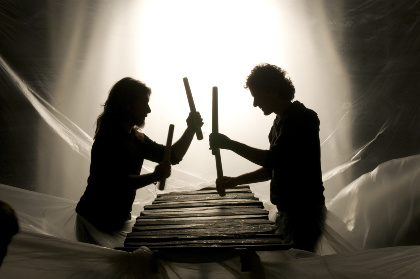- country:Spain
- region:Basque Region
- style(s):Basque, Roots
- label:Txalap.art ekoizpenak
- type:Band, Composer/Songwriter
- gender:male
- instrumentation:instrumental, percussion, visual
- artist posted by:Txalap.art ekoizpenak
Line up
- Harkaitz Mtez. de San Vicente (Wooden txalaparta, stone txalaparta, pipes, large )
- Iñigo Egia (Percussions (Indian tabla drums, cajon, bendhir, b)
- Juanjo Otxandorena (Bouzouki)
- Mikel Ugarte (Wooden txalaparta, stone txalaparta, pipes, large )
- Mixel Ducau (Alboka (hornpipe), saxophone, clarinet)
Links
Oreka TX is one of the leading groups promoting the txalaparta, pushing it as a musical instrument both in form and style. Harkaitz Martinez de San Vicente ( Donostia, 1975) and Mikel Ugarte (Oiartzun, 1973) are the txalaparta players of OREKA TX. The group was born on 2001 when they played on a band led by the noted basque composer, musician, and master of the trikitixa (diatonic accordion) Kepa Junkera, a collaboration that garnered them a Latin Grammy®. They have shared the stage and/or recorded with a host of international stars, such as Taraf de Haidouks, Pat Metheny, Alasdair Fraser, Hendingarna, Dulce Pontes, Phil Cunningham, Oskorri, Hevia ,Manu Dibango, Carlos Núñez, Joji Hirota …
Oreka Tx’s first album, Quercus Endorphina, was produced by Kepa Junkera and released by Elkarlanean in 2001. Tracks from this album were featured in the show “Txalaparta” by the famous Spanish dancer and choreographer Nacho Duato, represented by the National Company of Dancing at the most important auditoriums and theatres all over the world. In that year they formed their band (Oreka TX Band) and started to give concerts with it. They have also used festivals around Europe, America, Africa and Asia as a launchpad to gain awareness for the Txalaparta.
Nömadak Tx was their next project. Oreka Tx had a dream: they thought up a project that was to mark a turning point in the history of this unique musical percussion instrument. A project based on their understanding that the Txalaparta is a point of encounter, a means of communicating with others. Since 2004 they have travelled the world, using the Txalaparta as their vehicle and home, meeting musicians and discovering the reality of far away peoples, from Mongolia to Sahara, from Lapland to India. During their travels, they compiled visual and sound material, with a clear goal in mind: to share this music, these sounds, these images, and these experiences. Their dream became a reality and the result was an astounding documentary called Nömadak Tx which won multiple awards at international film festivals and is coming soon to theaters worldwide (the film was screened at WOMEX Film Programme 2007 at the section World Music Films on Tour), a CD distributed worldwide by Harmonia Mundi, a DVD and the a “Nömadak TX Live” which has participated in several festivals around the world.
Oreka TX, accompanied by musicians gathered together for the occasion, make an unusual concert - journey, in a combination of music and on-stage images. Played live, the richness of the sound and the variety of instruments provides the Txalaparta with an unusual yet welcoming environment, an environment in which the Txalaparta can evolve towards new horizons. The musicians play music created during their travels to India, Lapland, the Sahara and Mongolia, alongside other musicians who appear on a large screen. This screen, set at the back of the stage, becomes a huge window, to view and discover different places and different peoples. Experimentation and fusion are the tool of this new concept for multimedia concerts whilst cultural interaction is its goal.
After that they have developed several spectacles and projects like Hostoak (Leaves) that is a fusion between dance, chant and music. Their last spectacle HERRITMO is built around the concept of ‘balance’ through dance, live music, singing and rural sports. Basque rural sports, known as Herri Kirolak in Basque, is the term used for a number of sports competitions rooted in the traditional lifestyles of the Basque people The axes, stone, augers, saws, scythes inspire musical compositions. Also, the rhythmic movements of labor and the field are the inspiration for the choreography.These expressions brings a new area for this ancestral activities. A production that looks at the roots of the past with a view to the future. Song, music and dance together. A dialogue between arts which blends leading artists from different disciplines that taking the tradition have evolved and developed modern and contemporary approaches.
On 2014 they have released their last album (SILEX SiO2). The new album brings together the repertoire of their recent projects and develops the sound of his stone txalaparta. It also includes some collaborations with groups like Kalakan, Alos Quartet and We are Standard a well known group of electronic dance music.
WHAT’S
TXALAPARTA?
The txalaparta is a percussion instrument strongly linked to the Basque cultural identity. It is most often seen in the form of one or more planks of wood, mounted on insulating stands, played by two musicians who improvise simultaneously. Until it nearly disappeared in the 1960s, the txalaparta was a vital part of Basque culture, played during celebrations after making cider. This assemblage of wooden planks is the only known instrument whose rhythm and melody are played by two people who must communicate silently and without looking at one another, in order to create music that never belongs to a single musician. One player marks the rhythm, the other one breaks it, fractures it, neither mechanically nor precisely, but rather by creating something new, organic, and alive.
For OREKA TX the txalaparta is not only an instrument, it is an attitude, a way of connecting and becoming closer to one another. When playing the txalaparta, the musician cannot be selfish and introverted, but rather must learn to let go, to listen, to communicate, to create energy. This is the primal essence of the txalaparta just as its essential component, wood, is a raw material. Oreka Tx have experimented with using metal, marble and even ice versions of their instrument in the search for new sounds. The txalaparta is order and chaos, a balance between tradition and modernity, between erudite and primary blows, an improvised music.
















